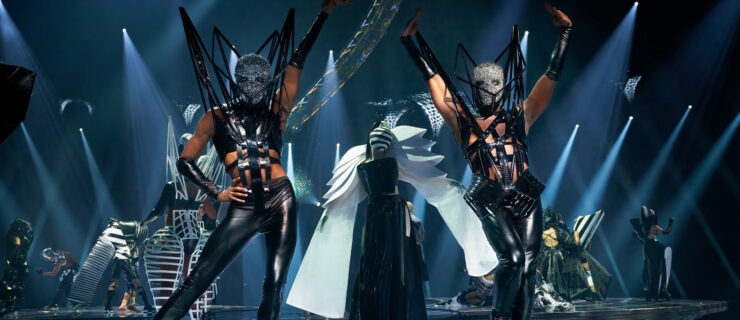Jessi Trauth lights up NYU as Sally Bowles in "Cabaret"
Jessi Trauth, a junior at NYU’s Tisch School of the Arts, recently nailed her performance as Sally Bowles in the school’s production of Cabaret. But this plum role is just one of many on this soon-to-be superstar’s resumé. After training at the Rocky Mountain Ballet Theater in Montana, Jessi fell in love with musical theater when she was cast in a community production of A Chorus Line. She was accepted to NYU’s Collaborative Arts Program, and, along with performing in school shows, she has landed parts in productions, including Wendy in Peter Pan and Eliza in The King and I, at respected regional theaters, like the Merry-Go-Round Playhouse. Plus last year she toured Europe as Velma in West Side Story before a knee injury sidelined her for a couple of months. After taking time to heal, 21-year-old Jessie landed back on top in NYC with genuine enthusiasm, awe-inspiring technique and undeniable charisma. Read on to learn more about her star turn at NYU. —Lauren Kay

Jessi with her costar Roe Hartrampf as Cliff. Photo by Chanel Pascente
April 18:
I just got cast as Sally Bowles, the lead in the Tisch Mainstage production of Cabaret! The legendary Tony Stevens is choreographing! Not only is he a master teacher and veteran Broadway performer in shows like Hello Dolly! and Seesaw, but he’s also the assistant choreographer on Fosse’s original Chicago.
Wait, how did innocent Jessi get cast as Sally Bowles? A fiery, promiscuous 19-year-old from Britain, Sally is the star performer in a cabaret in pre–WWII Berlin. She leads a wild life filled with sex, drugs and alcohol, and faces challenging dilemmas. Do I have enough real-life experience to pull this off? This will require digging into my most vulnerable places and experiences to find material that can inform my take on Sally’s problems.
June–August 24:
Over the summer I explore the character of Sally in my personal life: I drink alcohol for the first time and work on my flirtatious feminine power and I’m discovering that Sally and I aren’t as different as I thought. I work on memorization and the British dialect, as well as researching and reading about Weimar Germany.
August 18:
I can’t sleep the night before the first rehearsal! Unlike many other shows where you don’t meet the entire team (other than the cast) until the tech rehearsal, everyone attends Cabaret’s first day. The director Jean Randich, Tony Stevens, the dramaturge, and the costume, set and lighting designers share their concepts. So many of their ideas are fascinating and inspiring and the collaborative spirit in the room is kinetic.
Tony Stevens comes to all the rehearsals, even if they don’t involve choreography. He and Jean work together in such a supportive way. For example, Tony can give me acting notes and that is fine with Jean. Also, in one of the rehearsals for “Mein Herr,” Jean has a concept she really wants to include in Tony’s choreography. Normally visuals would be just for the choreographer to decide. But Tony and Jean are so open he tries her idea. That scene ends up being really incredible!
August 26:
Jean leads the cast in a clowning exercise. We put on red noses and are instructed to individually get up in front of everyone and do a forbidden act. As I creep out in front of the group, I suddenly think “Oh, how deliciously naughty it would be to strip!” I start to unbutton my skirt and immediately feel everyone caught in attentive suspense. With each piece of clothing shed, I become more surprised at myself, and the thrill increases. With breasts out and face red, I scamper away in shock.
Tony and Jean tell me they loved how my strip embodied the playful seduction Sally uses on Cliff and the audience in “Don’t Tell Mama.” They ask if I’m open to stripping in the show at the end of the number. Shocked but willing to try anything, I agree. Tony choreographs the strip and we decide I will be topless but my bottoms will stay on.
August 27:
Tony creates “Mein Herr” with me. He comes in with a concept and starts developing phrases of movement. He tweaks it until he’s satisfied that each step relates to the music and lyrics and tells the story, and that the choreography works on me specifically. “Don’t Tell Mama” and “Mein Herr” must introduce two of Sally’s contrasting characteristics: playful cutie and femme fatal.
At the end of the opening verse in “Mein Herr,” Tony and I work until the fanning of my fingers is reduced to the subtlest gesture and falls on the music after the lyric “Toodle-oo.” When played properly, Sally’s commanding ease captivates the audience.
September 4:
Now that I have the choreography, I need to go through every number and connect the specific motivation and inner dialogue with the steps and lyrics. Each time I perform it, tiny moments and new ideas pop up. The inner dialogue of a shoulder roll becomes “I can’t help it. I’m just a naughty girl.”
September 14:
My first serious boyfriend breaks up with me. I think of Sally’s line “…a woman can’t be a truly great actress until she’s…had her heart broken.” As much as this hurts, I use it to connect to Sally’s pain and heartbreak.
September 19:
As the show comes together, I understand more and more the importance of every moment in Sally’s journey. If I drop the ball at any point, the show is jeopardized. I must establish a strong connection with Cliff, the man I fall in love with, when he first catches my attention at the club during “Don’t Tell Mama.” This attraction is the catalyst for the rest of the show.
September 30:
Tech takes longer than expected and panic is in the air. Forty-five minutes before our last run without an audience, Tony and I block the number “Cabaret”—we didn’t have time in rehearsal! I see it as a challenge and test for myself.
I’m trying to get the new blocking in my body fast, nail the quick change into “Mein Herr,” and master sliding into the splits in four-inch, thigh-high boots. I get through the run without any disasters and even make my costume changes. Things feel hectic, though.
October 2:
Opening-night nerves and excitement! Even though everything goes smoothly, I am dissatisfied with my performance and feel that I could have done even more. I don’t want to celebrate. I feel emotionally drained and upset by Sally’s journey and am unable to let go of the show when I leave the theater. When playing an emotionally heavy role it’s important to leave the character at the theater to maintain your own emotional health. That’s a skill I haven’t mastered yet!
October 5:
I surrender the show to the greater good. My theme tonight is to revel in every moment. The power of the simple finger wave following “Toodle-oo” is deliciously thrilling. I feel the audience under my spell. I don’t feel as upset or drained. Is this good or bad? Does that mean I was faking it? I ask Jean and Tony. They think my performance was great. Maybe it’s better that I invited the audience in rather than throwing all my energy at them at once. I finally feel proud of my work!
October 8–10:
The last four shows go wonderfully! I’m at ease in the show, which allows for new discoveries. As I take my final bow, I know this is only the beginning of my career. Hopefully I will even get to play Sally again! This experience has changed me forever because I feel like I did things I didn’t know I could do. It showed me what kind of process I enjoy. Plus it emphasized that when creative teams provide room for growth, the possibilities are endless. If I’m ever a director or choreographer, I’ll remember how Jean and Tony worked and incorporate it into my own method. And lastly, the show reminded me that I absolutely have to do this. Performing and being an artist is the best thing—ever.




